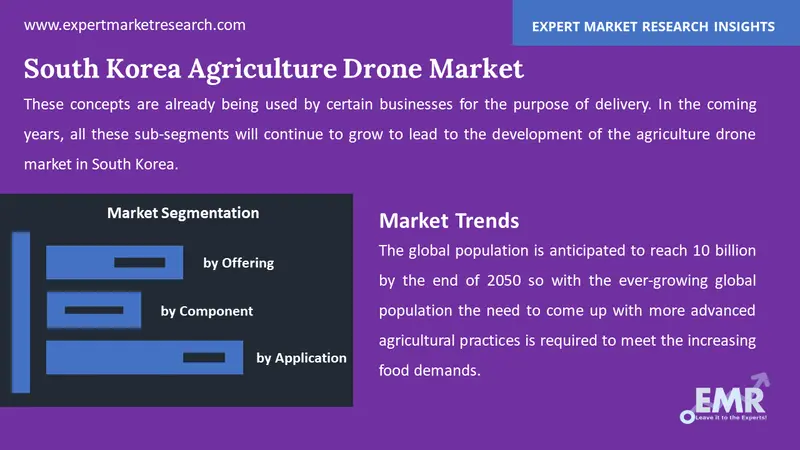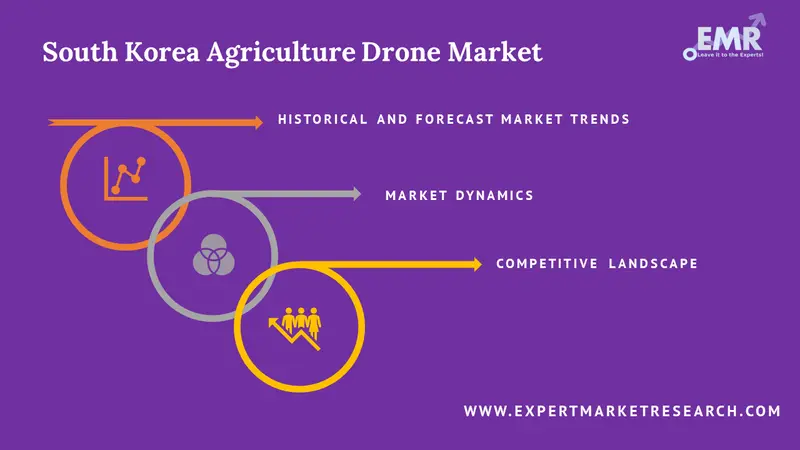
Consumer Insights
Uncover trends and behaviors shaping consumer choices today
Procurement Insights
Optimize your sourcing strategy with key market data
Industry Stats
Stay ahead with the latest trends and market analysis.
The South Korea agriculture drone market is expected to grow at a CAGR of 12.50% between 2026 and 2035. The growth of e-agriculture or information and communication technologies (ICTs) and automation, the increased focus on improving agriculture efficiency, and the increased need for water conservation are a few of the major factors contributing to the growth of the South Korea agriculture drone market.
Base Year
Historical Period
Forecast Period
Compound Annual Growth Rate
12.5%
2026-2035
*this image is indicative*
An unmanned aerial vehicle (UAV) known as an agricultural drone is used in agricultural operations, mostly for yield optimization and for monitoring crop development and output. Drones used in agriculture may gather data on soil differences, crop growth phases, and crop health.
Growing R&D Work and New Technologies Drive the Development of the South Korea Agriculture Drone Market
It's a common misconception that agriculture and modern technology don't blend. Agriculture has always been a leader in the adoption of new technology, modified seed, embracing motor/power, pesticide, and harvesting-related technologies over many decades to increase production. But it's also true that most aspects of agriculture are still manual and analogue. This is mostly due to the technological limitations that have, up until now, prevented automation.
However, this is changing, partly because of advancements in two key technologies which are autonomous mobility and CNN-based machine vision. These continuous research and development and the launch of new technologies are opening the door for new product categories, agricultural techniques, and even business models. AI-based machine vision and agricultural robots reflect the progression of agricultural equipment and machinery, thereby augmenting the agriculture drone industry of South Korea.
Smart Agriculture Technologies Aid in Addressing Unforeseen Circumstances and Manpower Shortages in the Country
The global population is anticipated to reach 10 billion by the end of 2050 so with the ever-growing global population the need to come up with more advanced agricultural practices is required to meet the increasing food demands. However, the percentage of the population engaging in agricultural work is likely to decrease with time. Moreover, factors such as climate change, water shortage, ageing population, crop destruction, and lack of land for agriculture, among others further increase the importance of these smart technologies in the agriculture sector, which bolsters the market of agriculture drone market in South Korea.
Government Support to Farmers Bolster the Agriculture Drone Market in South Korea
During the COVID-19 outbreak, the manufacturing and supply chains were severely disrupted, which affected the market for agriculture drones globally, including in South Korea. However, according to the decision made by the Youth Policy Coordination Committee, the Ministry of Agriculture, Food, and Rural Affairs (MAFRA) have increased the amount of assistance it offers to young farmers and those working in industries connected to food and agriculture. Support from the government is one of the most motivating factors for people to engage in agriculture, thus boosting the adoption of smart technologies such as agriculture drones in South Korea.

Read more about this report - REQUEST FREE SAMPLE COPY IN PDF
The EMR’s report titled “South Korea Agriculture Drone Market Report and Forecast 2026-2035” offers a detailed analysis of the market based on the following segments:
Market Breakup by Offering
Market Breakup by Component
Market Breakup by Application
Based on offering, fixed wing drones have more of a traditional aeroplane appearance and need a runway or a catapult to take off. Unlike quadcopters and single-rotor drones, this unmanned aircraft system cannot take off vertically, nor can it hover. Compared to other options on the market, they are frequently more expensive and demand more expertise. Helicopter-shaped drones combine the finest features of both small multirotor and big single-wing aircraft. The newest drone technology to hit the market is fixed-wing hybrid versions. They combine a rotor-based device's ability to lift off vertically with the long-range and flying duration of fixed wing drones. This hybrid technology is a new option for usage with commercial drones because of its adaptability. These concepts are already being used by certain businesses for the purpose of delivery. In the coming years, all these sub-segments will continue to grow to lead to the development of the agriculture drone market in South Korea.
The software and services segment is anticipated to grow owing to the R&D work and the growing inclination toward high technology in South Korea. Drone mapping software collects crucial information, analyses it, and draws forth insightful conclusions that may be used to design a more effective and efficient farm management system. The most advantageous improvement for agribusiness is probably drone mapping software since it makes it possible to identify and manage hazards early on, improve crop measurement and evaluation, as well as identify and take into account trends. All of the aforementioned factors will unavoidably increase efficiency, productivity, and operational expenses while lowering risks to the organisation as a whole.

Read more about this report - REQUEST FREE SAMPLE COPY IN PDF
Plant health is shown by drones with the use of specialised imaging technology called the Normalized Difference Vegetation Index. This enables farmers to keep an eye on crops as they develop so that any issues may be resolved quickly enough to protect the plants. Crop health is also tracked by drones using cameras. Precision agriculture may use such systems as drones can be outfitted with motor systems, batteries, GPS, ultrasonic echoes, and lasers to maintain their height over the crop. In the upcoming years, it is anticipated that these drone improvements will accelerate the market's growth.
According to some research, utilising precision agricultural techniques can boost output. Precision farming maximises the use of land and current agricultural techniques. To monitor the yield, several types of cameras are attached to the drones. Drones with infrared imaging capabilities and high-definition cameras can assist farmers in remotely monitoring their cattle. Feeding management, heat stress management, animal comfort management, and behaviour monitoring and control are the primary sub-applications of livestock monitoring.
Fish farming is a type of aquaculture that includes breeding fish for commercial purposes in enclosures or tanks. Increased fish farm output is required to meet rising food demand. Fish monitoring and fleet navigation, feeding management, and water quality control are some of the major applications for fish farming. Drone usage has already become a crucial component of extensive precision agricultural operations in several regions. Farmers may better plan their plantings and treatments by using the information gathered from drone recording fields. These applications and benefits of the segments aid in bolstering the growth of the agriculture drone market.
The comprehensive EMR report provides an in-depth assessment of the market based on the Porter's five forces model along with giving a SWOT analysis. The report gives a detailed analysis of the following key players in the South Korea agriculture drone market, covering their competitive landscape and latest developments like mergers, acquisitions, investments and expansion plans.
Preneu Co. Ltd is a major drone business in Korea that offers cutting-edge drone systems and services by fusing drone and aviation hardware production, IT core technology, and software development. PRENEU's unmanned aerial vehicle and system are designed and manufactured independently, enabling them to be used for tasks like surveying, search, reconnaissance/surveillance, and inspection. It offers a platform-based service that can maximise the utility of drones through the fusion of IT technology.
XAG Co., Ltd is committed to transforming the agricultural production industry via the use of drones, robotics, autopilot, artificial intelligence, and the Internet of Things. By building a smart agriculture ecosystem, it ushers in the era of agriculture 4.0, which is characterised by automation, accuracy, and efficiency. XAG was founded in the year 2007 and has its headquarters in Guangzhou, China.
*Please note that this is only a partial list; the complete list of key players is available in the full report. Additionally, the list of key players can be customized to better suit your needs.*
Other key players in the South Korea Agriculture Drone Market are SZ DJI Technology Co., Ltd, Helsel Co., Ltd, GiantDrone Co., Ltd, UconSystem Co., Ltd., among others.




*While we strive to always give you current and accurate information, the numbers depicted on the website are indicative and may differ from the actual numbers in the main report. At Expert Market Research, we aim to bring you the latest insights and trends in the market. Using our analyses and forecasts, stakeholders can understand the market dynamics, navigate challenges, and capitalize on opportunities to make data-driven strategic decisions.*
Get in touch with us for a customized solution tailored to your unique requirements and save upto 35%!
The market is projected to grow at a CAGR of 12.50% between 2026 and 2035.
Support from the government, high demand for technologies, an increase in automation, technological advancements, and benefits to the crops are the major drivers of the South Korea agriculture drone industry.
The key trends in the South Korean agriculture drone industry are the proliferation of smart agriculture technologies and increased R&D work.
The major players in the industry are SZ DJI Technology Co., Ltd, Preneu Co. Ltd., Helsel Co., Ltd, GiantDrone Co., Ltd, UconSystem Co., Ltd, and XAG Co., Ltd, among others.
Explore our key highlights of the report and gain a concise overview of key findings, trends, and actionable insights that will empower your strategic decisions.
| REPORT FEATURES | DETAILS |
| Base Year | 2025 |
| Historical Period | 2019-2025 |
| Forecast Period | 2026-2035 |
| Scope of the Report |
Historical and Forecast Trends, Industry Drivers and Constraints, Historical and Forecast Market Analysis by Segment:
|
| Breakup by Offering |
|
| Breakup by Component |
|
| Breakup by Application |
|
| Market Dynamics |
|
| Competitive Landscape |
|
| Companies Covered |
|
Datasheet
One User
USD 2,499
USD 2,249
tax inclusive*
Single User License
One User
USD 3,999
USD 3,599
tax inclusive*
Five User License
Five User
USD 4,999
USD 4,249
tax inclusive*
Corporate License
Unlimited Users
USD 5,999
USD 5,099
tax inclusive*
*Please note that the prices mentioned below are starting prices for each bundle type. Kindly contact our team for further details.*
Flash Bundle
Small Business Bundle
Growth Bundle
Enterprise Bundle
*Please note that the prices mentioned below are starting prices for each bundle type. Kindly contact our team for further details.*
Flash Bundle
Number of Reports: 3
20%
tax inclusive*
Small Business Bundle
Number of Reports: 5
25%
tax inclusive*
Growth Bundle
Number of Reports: 8
30%
tax inclusive*
Enterprise Bundle
Number of Reports: 10
35%
tax inclusive*
How To Order

Select License Type
Choose the right license for your needs and access rights.

Click on ‘Buy Now’
Add the report to your cart with one click and proceed to register.

Select Mode of Payment
Choose a payment option for a secure checkout. You will be redirected accordingly.
Gain insights to stay ahead and seize opportunities.

Get insights & trends for a competitive edge.

Track prices with detailed trend reports.

Analyse trade data for supply chain insights.

Leverage cost reports for smart savings

Enhance supply chain with partnerships.

Connect For More Information
Our expert team of analysts will offer full support and resolve any queries regarding the report, before and after the purchase.
Our expert team of analysts will offer full support and resolve any queries regarding the report, before and after the purchase.
We employ meticulous research methods, blending advanced analytics and expert insights to deliver accurate, actionable industry intelligence, staying ahead of competitors.
Our skilled analysts offer unparalleled competitive advantage with detailed insights on current and emerging markets, ensuring your strategic edge.
We offer an in-depth yet simplified presentation of industry insights and analysis to meet your specific requirements effectively.
Share